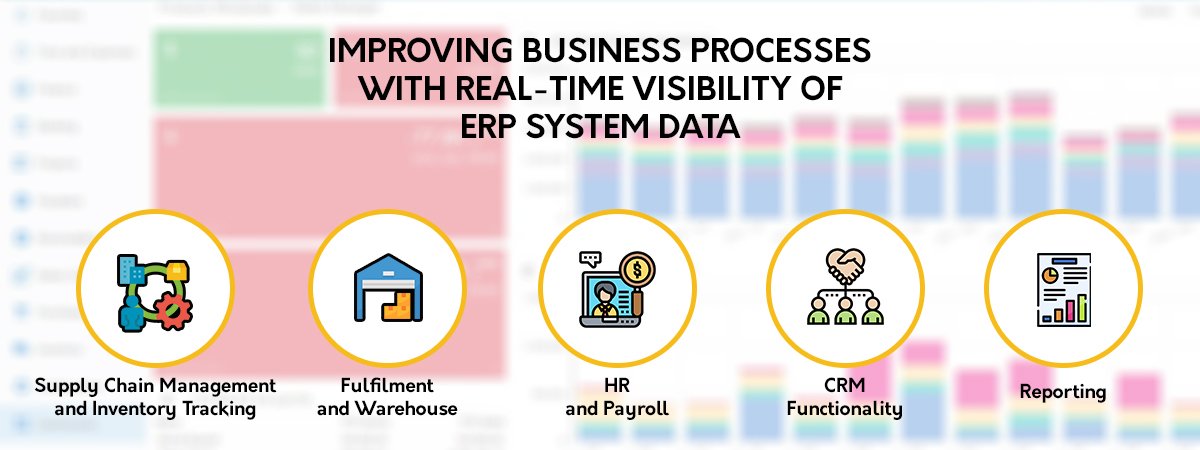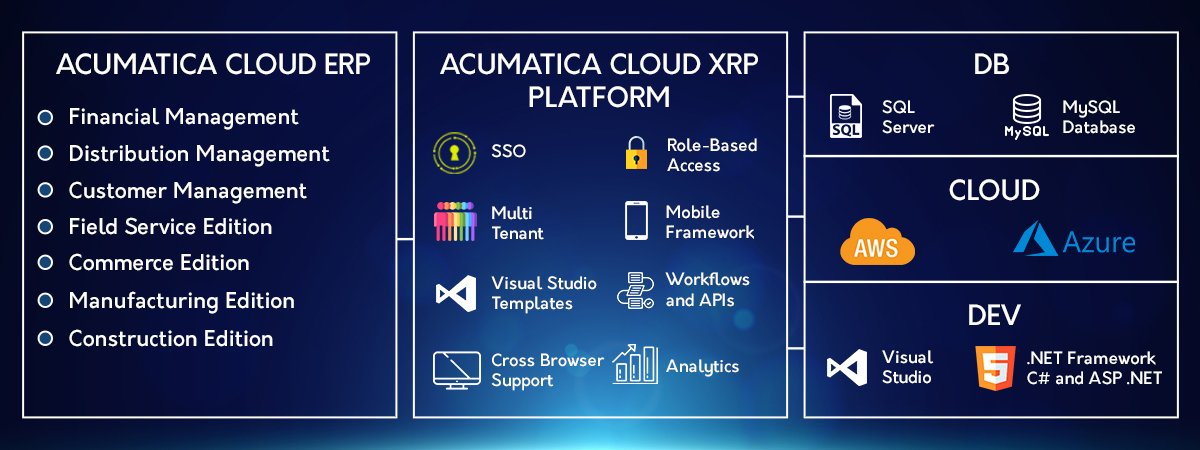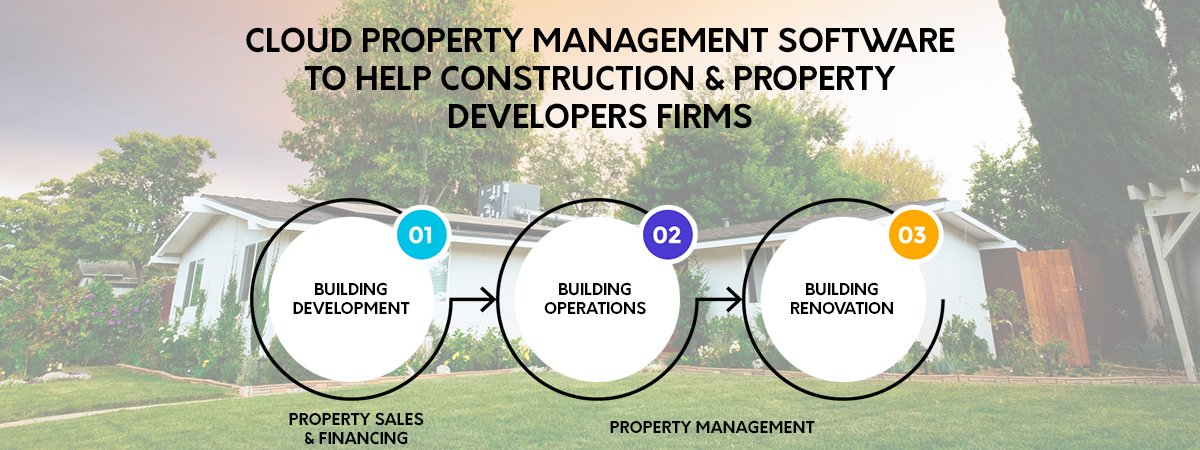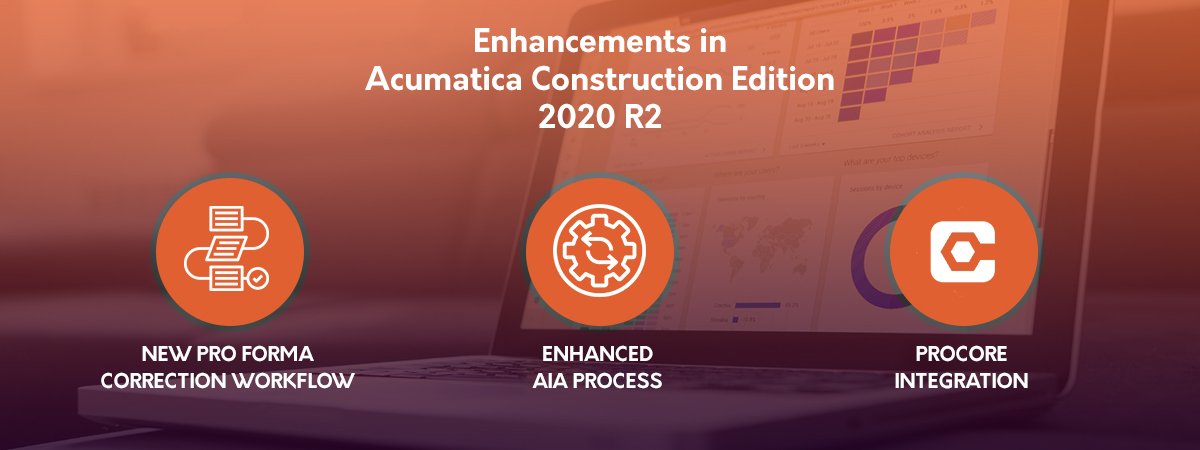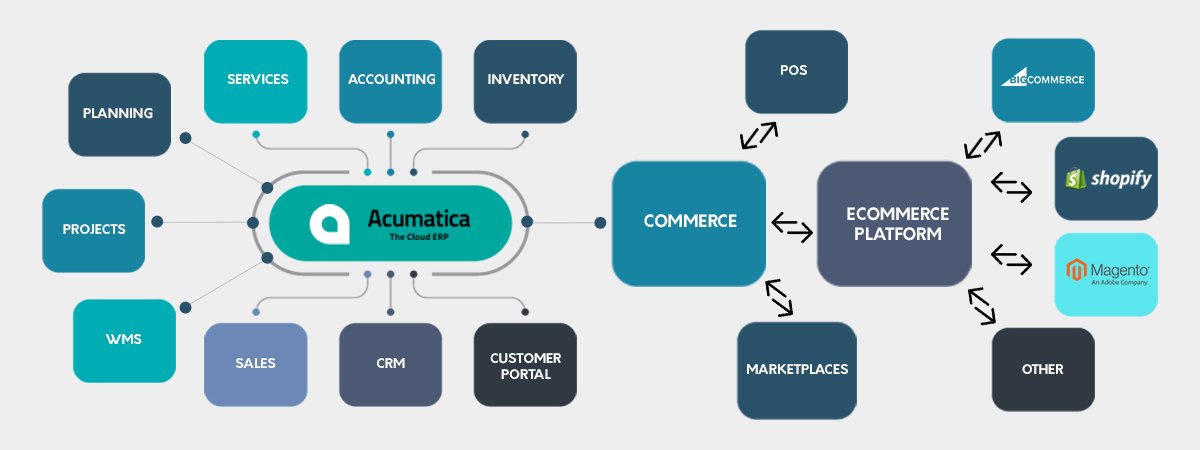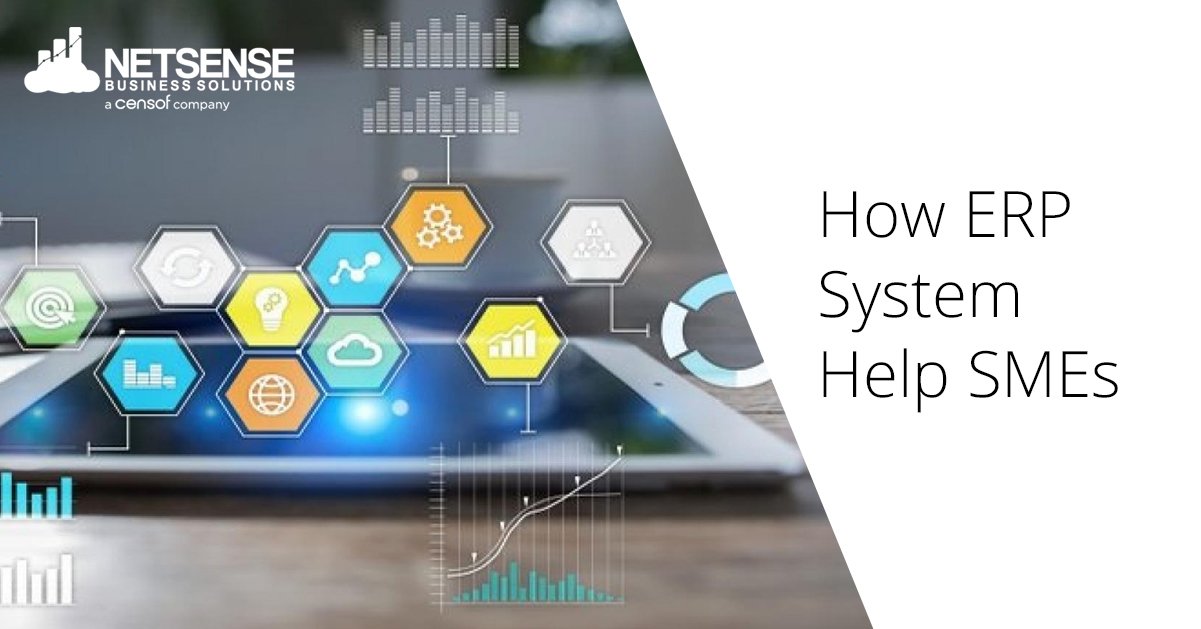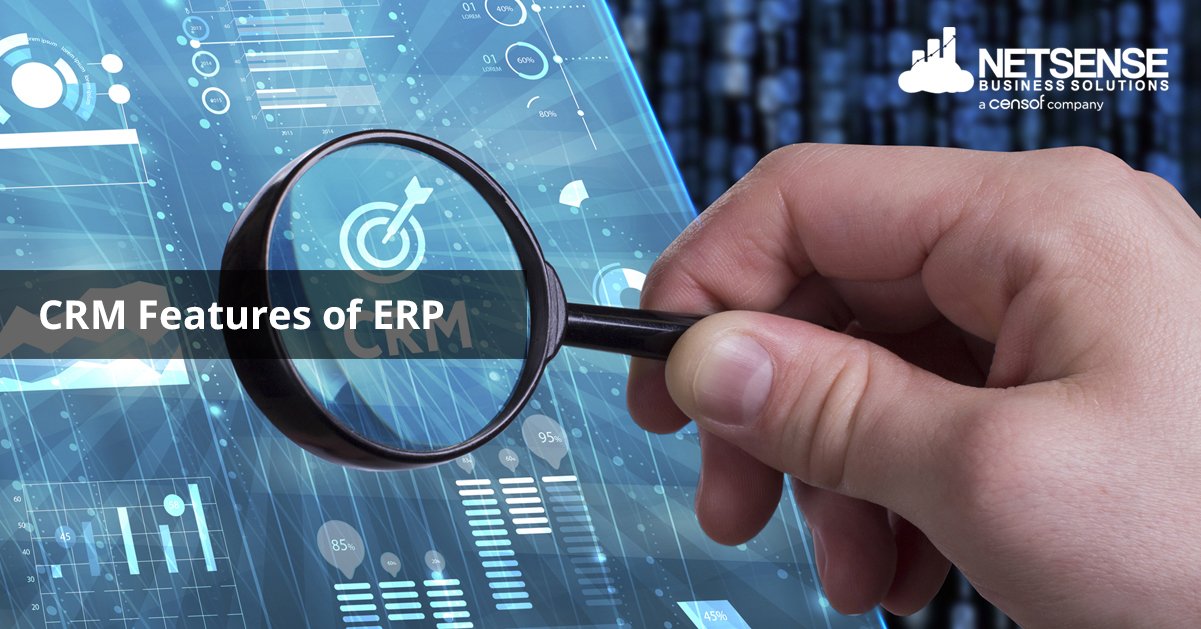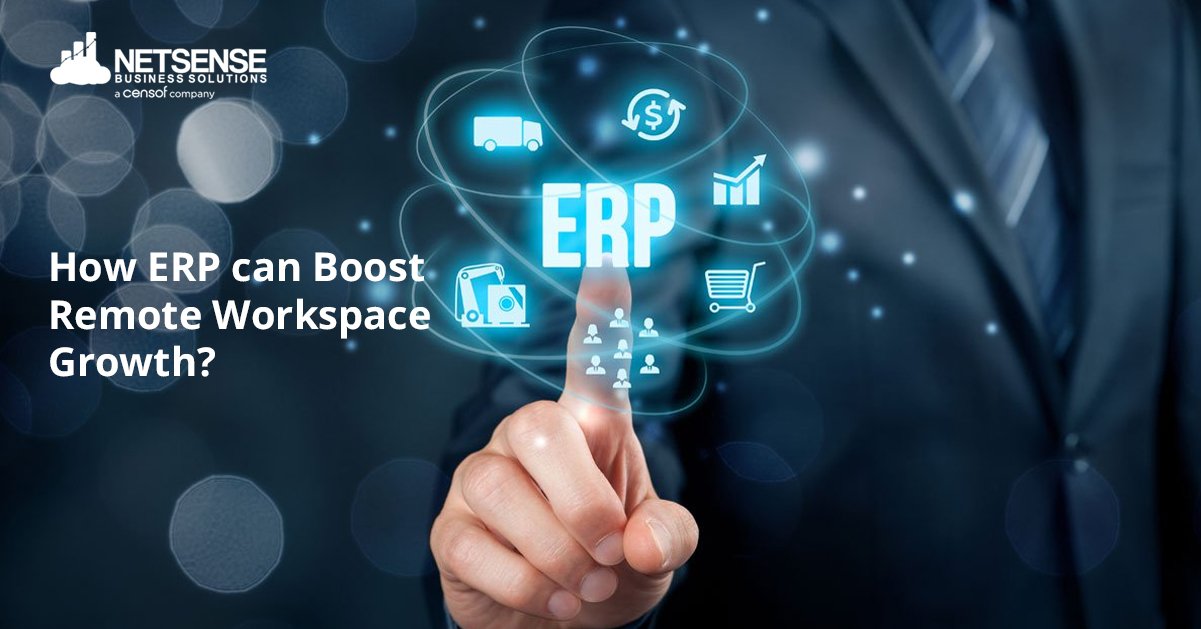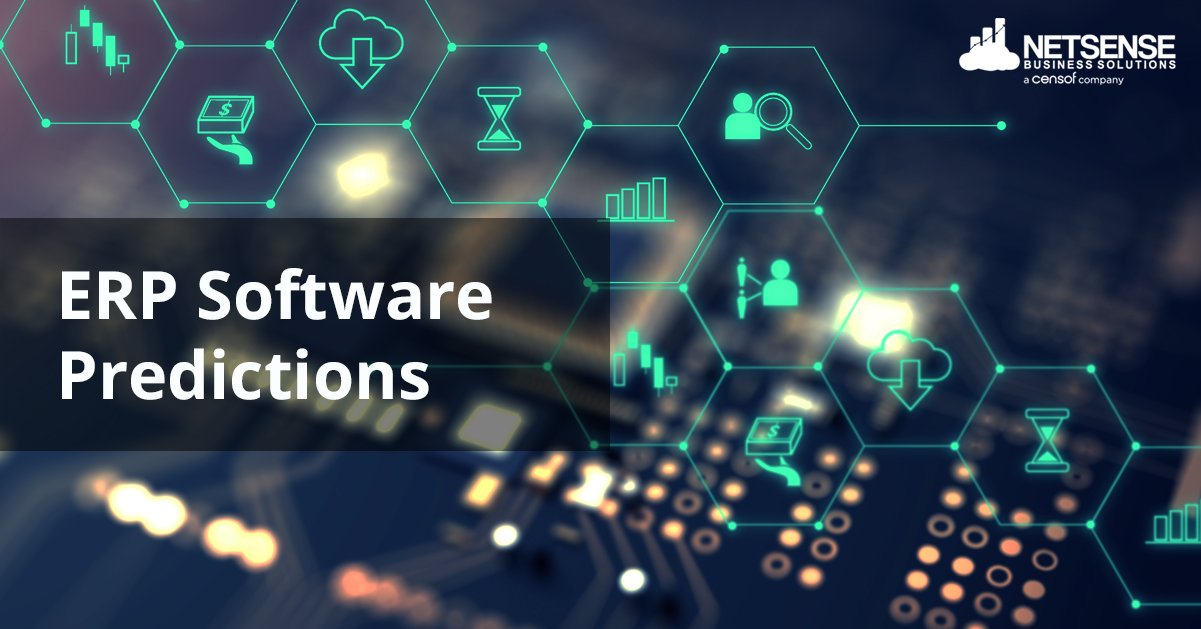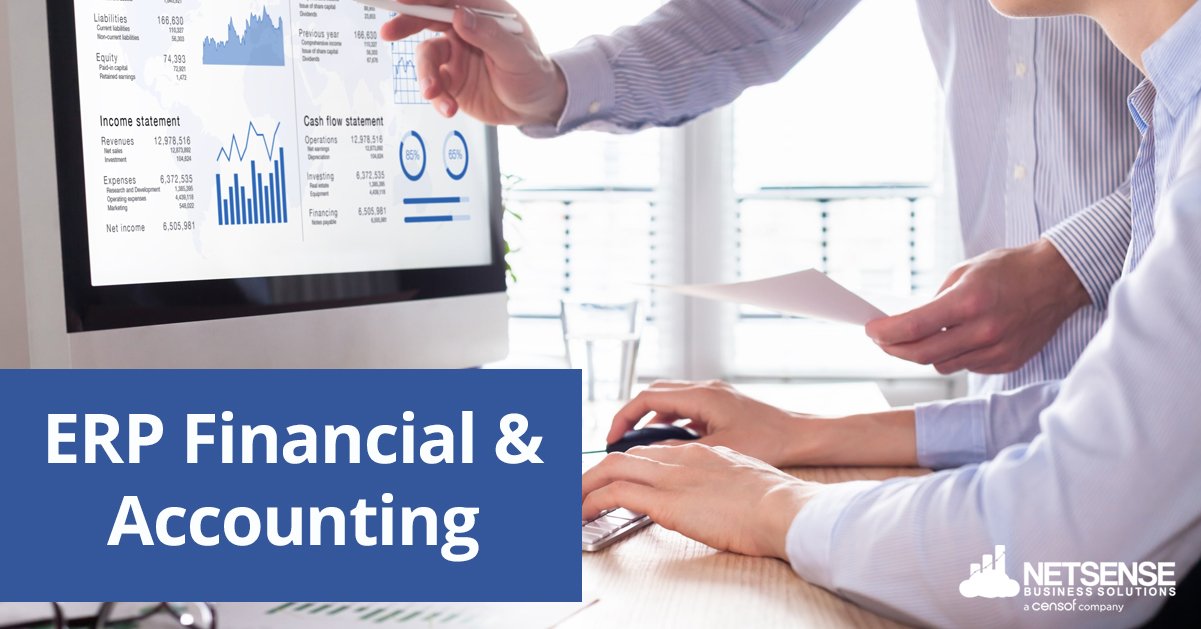With consumers’ increased demand for a high level of visibility into product status throughout the transaction, companies couldn’t overlook a suitable data collection technology to determine what’s in stock, what’s being produced, what they need to re-consider. They can no longer rely on manual efforts or scattered spreadsheets to gain visibility into business insights, otherwise, it will lead to more labour costs, project delays, excess inventory, and human errors. No matter whether you’re a manufacturer, distributor, or property manager, you have to see what’s happening within your organisation to make a good shot at effectiveness and profitability. Despite knowing the value of real-time information, many SMEs still unsure what they need or where to begin. With advances in cloud and computing power in Enterprise Resource Planning (ERP) system, companies can increase visibility in all departments to track performance and results of specific processes and goals. How Lack of Visibility Can Hurt Your Business? The recent Zebra Technologies study reveals that almost 40% of companies are still not using mobile computers or mobile barcode scanners. Without real-time barcode scanning and data accumulation, managing inventory could be a challenging task, which may lead to mistakes and have a negative impact across the entire business. Therefore, you shouldn’t stack applications on to accounting systems and then export data into several spreadsheets to figure out what’s happening. Here are some problems that can be caused due to lack of visibility: Data entry errors – Manual data transactions often lead to errors, which further creates inventory inaccuracies and shipment errors that can be tricky to detect. Unnecessary labour costs – Without barcode scanners, you need to invest a lot of time typing data into computers and inspection is necessary to fulfil the order. Excess inventory – Inaccuracy of inventory data can lead to unnecessary purchases and high inventory expenses, which can cut into profitability. Delay in decision making – Without useful insights, you cannot keep your teams informed and updates, which holds users back from making smart and more informed decisions. How does Cloud ERP System Help Companies Improve Visibility? With a cloud-based ERP solution, you will receive a tool that enables you to build knowledge and vision directly within a single database, eliminating the strain of synchronising disparate systems and information. The integrated data provides you with real-time visibility, making sure that you are focused on making the right decisions in the right area. Supply Chain Management and Inventory Tracking The ERP system gives you real-time visibility into several warehouses and entities – all the information available at your fingertips. This way, you will gain a clear picture of where everything is, what’s in transit, and which products are stored on trucks, and other key pieces of information. Fulfilment and Warehouse The ERP solution allows users to see the entire supply chain, right from the acquisition of products to customer delivery to help understand actual and projected sales. With accurate and timely information, you can streamline, automate, and meet your customer relationship goals more effectively. You can anticipate challenges and overcome them early to exceed your future needs. HR and Payroll When you have two functions integrated into a single software, HR and payroll processes can run automatically which reduces the risk of errors or keep it to a minimum. A manager will simply receive a time-off request that can be immediately processed through the system and sent to the key employees. CRM Functionality The integrated ERP with efficient CRM can help strengthen business processes like sales, returns, payments, billing, and budget. It not only streamlines workflows but also improves customer relationships. Reporting Every organisation works on a variety of reports that should be generated and shared on a consistent basis. Instead of struggling with thousands of spreadsheets, using an ERP solution can help to generate reports in a clear and comprehensive format. How Netsense Can Help to Transform your Business Processes? At Netsense, we never take our clients’ needs for granted and are consistently working to deliver best-in-class features and functionality in our ERP solutions. We deliver a scalable Acumatica ERP system with a number of product suites like project accounting, smarter integration, cloud-based, and mobile resource management tools that bring changes in real-time. This way, you can effectively manage complex projects, enhance reporting, and exchange data in real-time across all departments within the organisation. If you have any queries about the Acumatica ERP solution, you can connect with our experts and also request a demonstration to attain a clear understanding. We assure you, it will be a time worth investing.
To thrive in a competitive and complex business environment, companies and leaders need to put a technologically advanced system in place that allows them to streamline, automate, and scale. From minute details to major change, one mistake could cut down the profits, strain customer and partner relationships, and ruin your company’s reputation. With every cloud ERP vendor attracting buyers’ attention by promising the best solution, it can be daunting to select the suitable one. Suppose, when something is broken or damaged, you turn to the repairing expert likewise, you should look for the experts that offer best-in-class features and functionality in one solution. That’s why, many users support the appeal of industry-specific ERP, providing necessary modules for a company’s specific industry that reduces time, cost, and risk. Why Industry-Specific ERP Solution Matters? Selecting and implementing cloud ERP software is a crucial and long-term decision. It takes a significant amount of time and effort to pick amongst a plethora of choices available in the market. It is always ideal to rely on a solution that serves your industry in the best possible manner while having the flexibility you need as your business grows. Industry-specific ERP is tailored to meet or exceed the needs of a particular industry. Just as you count on a highly trained mechanic to modify your car, you can simply use a full-fledged solution to run business processes smoothly, including distribution, field service, production, commerce, and construction. A cloud-based industry-specific ERP system is built with the exact features and capabilities you need to achieve success in your niche market. Which is Better – Industry-Specific ERP or Generic ERP? Industry-specific ERP solutions generally have better applicable functionality as they are built around definite needs with a clear understanding of industry processes. If we talk about ‘one-size-fits-all,’ Generic ERP comes first into the mind, offering resources for product development which may or may not fit perfectly for industry-specific users. In addition, it requires some sort of customisation, add-ons, and enhancements to meet the precise business needs to gain a competitive edge. Well, these customisations can be an expensive and time-consuming affair, as well as it barely does the job and adapts to the environment when processes or technologies evolve. This is why the Acumatica ERP system offers the best of both the worlds that can serve industry-specific or generic functionality depending on business needs with core features and user-friendly cloud technology. By fully embracing the flexibility of the ERP system, you don’t need to choose between industry-specific and generic functionality. Acumatica ERP being the cloud-based system, offers industry editions to fulfil industry-specific standards and support powerful practices without compromising on mobility, integrations, and data transparency. Why Choosing from Acumatica Industry-Specific Edition is a Viable Option? Is your existing generic ERP solution couldn’t connect well with financials? Do you need a reliable platform to create new product landing pages? You can solve such issues by moving to the Acumatica ERP system that is tailored to meet or exceed to fit your best interest with a deep understanding of ins and outs of your industry. At Netsense, we offer Acumatica ERP Industry Editions, including Distribution, Manufacturing, Field Service, Construction, Retail and E-commerce, and more to eliminate the burden of keeping up with industry standards and regulations. We continue to bring user-friendly ERP solution to offer superior usability, smart industry-specific solutions, and advanced business capabilities that enhance efficiency and profitability. Whether you’re planning to outgrow your current software or looking for something more suitable for your business processes and needs, we ensure to provide you with genuine advice to ease your ERP implementation journey. We invite you to see a demonstration of our ERP solution to learn more about its functionality and modules. Are you ready to take the next step? Contact us today to reach ultimate success!
Property managers, property developers or real estate owners, be it commercial or residential faces several challenges in fabricating materials, managing complex projects, and keeping the workforce on the same page. The construction industry is booming significantly and one contributing element is indeed cloud-based technology. While the construction & Property development industry seems fast to use advances in processes, some professionals are slow to integrate scalable technology into their applications. Just as a second story can’t be incorporated in the property unless the foundation is strong enough to support the weigh and access, similarly, you cannot expect unique functionality in standalone systems. As the majority of ERP vendors entering the cloud ERP market, Acumatica ERP made a successful move to cloud property management software to help construction & property developers firms gain competitive advantage. The core of the Acumatica ERP is based on several modules like finance and accounting, which property managers and teams can operate with a single dashboard to view and edit accounting reports, CRM, work order management, and much more. Ready to learn more? Let’s dive in! How Property Management Solution Tackles Challenges of Property developers ? Construction companies & Developers are typically stuck in manual-intensive reporting, scattered spreadsheets, and data silos. But thankfully, all such tedious tasks are gradually falling behind with modern and scalable ERP solutions. Acumatica cloud-based property management solution is built to help property managers improve operational efficiency and overall bottom line. Acumatica & Infosoft (Acumatica ISV Partner) has made the solution more technologically advanced and fast-forward with world-class functionality and support. Netsense has partnered with Infosoft to implement Module “RED” (Real Estate Dimension) in Malaysia and Singapore. Here’s how cloud-based ERP can help real estate organisations overcome challenges: Work order management is enhanced through automation capabilities such as eDocument creation for leases and contracts. Manage Sales Booking and Loan process for new property bookings Manage Discounts and vacancy rates Being built on cloud technology means all relevant information is stored in the cloud that users can access and gain useful insights from anywhere at any time. A cloud-based ERP system offers flexible billing options which prove to be very useful if you deal with a variety of packages for multiple tenants. It has made customer service and support much easier with separate web portals for vendors, leaseholders, and partners. Lease renewal and vacancy ratio challenges become a lot simpler as vacancy management combined with renewals. How the Acumatica ERP System is at the forefront of Technological Advancement? Users can trace the proven success of Acumatica from the development of the xRP platform, the fundamental technology that powers cloud-based ERP software. Infosoft introduced a new module “RED” built within Acumatica for Property Developers. “Customers who want to stay competitive need flexible, responsive technology to execute their long-term business strategies. Our ACA label is built to help customers find applications capable of delivering that,” says Vice President of Partner Solutions at Acumatica. Back then, the usage of computers in real estate workflows was virtually non-existent. Since then, the technology has significantly evolved and throughout this revolutionary wave, Acumatica ERP solution continues to grow in three key areas i.e. project management software, cloud ERP and managed IT services. Key Features of Property Management Solution Flexible tenant billing options Highly diversified collection management Tracking and traffic analysis Lease renewal and vacancy management reporting Work orders management Automated workflows and recoveries Utility billing Tenant service billing User-defined and programmed lease abstracts Property and tenant timely reminders Seamless integration with industry-leading financial modelling software And many more How Netsense can Help Streamline Processes of Real Estate Organisations? At Netsense, we are a trusted leader in this niche and has been bringing the highest quality Acumatica ERP solution for both commercial and residential real estate owners, operators, managers. We are offering a fully integrated, future-centric, and customer-focused system to help our clients keep up with current trends and gain a competitive edge over others. Our ERP solutions are filled with optimum capabilities, ideal for leasing, vacancy management, contracts, amenities, property features, and much more. Through this, property managers can streamline and automate their workflows, offering them more time and flexibility to add value to their business to flourish today and in the future. For more clarity about our Acumatica ERP solution for real estate organisations, you can schedule a demonstration with our experts and see the advanced system in action. For further queries and assistance, call us today!
There is no denying that the construction industry can face reduced productivity due to lack of collaboration, inefficient project planning and estimation, resistance to digitalisation, lack of transparency, and time overruns. With global competition and increasing administrative needs, contractors are pushing themselves to incorporate advanced business solutions to simplify complex projects and see a clear picture of future growth. Using technology to synchronise and monitor business processes is nothing new in construction companies. Here’s the good news, now Acumatica 2020 R2 is available, allowing contractors, land developers, and builders to set up for success with superior, simplified user experience. It aims to provide users with a modern, updated design with best-in-class functionality that saves time and ensures the entire construction project cycle runs smoothly and efficiently. How Acumatica Construction Edition 2020 R2 is Suitable for Construction Companies? The final goal of any construction company is to meet or exceed the clients’ expectations while generating maximum revenue to make a great shot at success. Acumatica Construction Edition is built on three pillars of true cloud, high value, and real-time, increasing productivity and helping companies to work smarter, not harder. Acumatica ERP system is designed on the cloud which allows users to obtain seamless integration with every suite, including financial management, CRM, inventory management, production, and field service management. With real-time visibility into insights, all the departments always stay informed, updated, and ready to implement an innovative strategy. Here are some enhancements you will find in Acumatica Construction Edition 2020 R2: New Pro Forma Correction Workflow Companies don’t need to rely on manual efforts anymore. You can simply improve billing cycle efficiency without AR invoices or manual reversing before billing. You can use multiple methods to correct pro forma and receivable invoices, including entering a credit on the next invoice, revise the previous billing without removing the AR invoice, or adjust retainage using credit memos. Enhanced AIA Process Past versions may have integrated customisations or user-defined areas to put up different situations, resulting in additional procedures and delayed billing cycles. The new enhancements in Acumatica 2020 R2 will streamline cash flow with automated capabilities and workflows, such as retainage pro forma for AIA printing, historical change order and billing values, and AIA application number. Procore Integration Office personnel and project managers within the construction field will now enjoy even more mobility in the management of operations than ever before. With an enhanced integration system, you can easily delete or inactivate records and create single-directional or two-directional imports and manage updates on several entities under any scenario. The project Preferences option gives project managers a chance to decide which project-related entities to sync like cost codes, project tasks, budget, etc. When the initial configuration is finished, you can automate processes to keep stakeholders, vendors, and customers informed. It includes several features such as procore monthly sandbox connectivity for testing purposes, synchronisation logs, linking and unlinking records, both manual and automated synchronisation, and bi-directional data flow options. Benefits of Acumatica Construction Edition 2020 R2 A Single Source of Truth Despite spending a fortune on several back-office applications and systems and then investing time in making decisions, you can rely on an all-in-one ERP solution to do the entire job. All your data is stored in the cloud, which means you can use a complete system to access business data, import spreadsheets, and integrate it with accounting, CRM, project management, and more. Comprehensive Project Management Acumatica Construction Edition uses mobile and cloud technology to simplify collaboration, accumulate project requirements and status, solve issues, and stay on the top of every detail, such as budgets, labour costs, materials, and more. Real-Time Information and Flexibility You can access all the information in real-time, from anywhere at any time. Moreover, you can check reports like project and purchase orders, from any browser-enabled device, each offers the same features and functionality. At Netsense, we are offering an advanced and scalable Acumatica ERP system for the construction industry to allow businesses to achieve success using integrated and automated mobile and cloud technology. The number of companies has implemented our full-fledged ERP solutions to manage project orders, inventory, budget, change orders, and everything else. If you’re looking for modern cloud ERP software to streamline your business operations, we can help you get started. Have any further requests or query regarding ERP solution, or would like to see a demonstration? If yes, please contact our experts now!
Since the e-commerce market has been flourishing significantly, more and more businesses are making a shift from brick-and-mortar stores to online stores to embrace consumers’ shopping experience. Now more than ever, consumers are inclined towards convenience and purchase products online, thus, having a fully integrated solution is extremely important to manage unpredictable demands, offerings, and online presence to thrive in a bustling environment. Establishing an online platform is good, but if you aren’t equipped with an advanced and scalable enterprise management solution, you are likely to miss out on a number of opportunities. Take a moment to think about the last time you dealt with manual, repetitive tasks. With the universality of technology in the digital economy, it already appears that you don’t need to manage tasks in the same, old manner, and implementing Acumatica ERP Commerce Edition is a way out. Why Choose Acumatica Commerce Edition? Acumatica Commerce Edition is a centralised, cloud-based, and result-driven ERP solution involving best-in-class features and performance capabilities, ideal for both B2B and B2C players. With tight integration to CRM, financials, warehouse, inventory, and distribution, you can enjoy real-time visibility and control over order requests and fulfilment. Basically, you can integrate any industry-specific tools with Acumatica Cloud ERP to accelerate your business growth to its full potential. It gives the ability to handle all operations from order management to inventory, picking, packaging, shipping, returns, accounting, and customer support – everything from a single dashboard, enabling continuity and resilience for small and mid-sized enterprises. How Acumatica ERP System is Beneficial for Your E-Commerce Business? Provide an Omnichannel Experience You can streamline the creation of items with various attributes, including material, size, and colour. Since Acumatica Commerce Edition can help you monitor business operations like shipping, warehousing, etc., you can overcome obstacles and continue to thrive even under challenging circumstances. Gain a Single Version of Truth It can centralise your processing for all sales channels via single-stream fulfilment for the counter, online, and telemarketing sales. You can easily connect your BigCommerce, Magento, or Shopify storefront with Acumatica ERP’s flexible back-office system to manage all tasks from a single database, from anywhere at any time. Streamline Order Processing and Fulfilment With automation capabilities, you can print barcode labels and scan the goods when placed in a box and approve shipment procedures which reduces shipping and packaging errors. You can even combine it with ship stations for better efficiency. Gain Comprehensive Business Insight Whether your customers place orders for products over the phone, purchase in-store via POS, or place an order via the web store, all purchase activities are accumulated in a single dashboard. With a 360-degree view of customer purchases and activities, you can mitigate stock-outs and back orders. Powerful Applications of Acumatica Commerce Edition 1. Advanced Inventory Management It gives real-time access to inventory availability, reorder quantities and costs which efficiently handle your distribution process and improve customer satisfaction. 2. Warehouse Management System (WMS) It streamlines the inventory receiving, management, and order fulfilment which means enhanced warehousing operations. You can use mobile phones and tablets for barcode scanning to ensure accurate part selection. 3. Advanced Financials Acumatica cloud ERP comes with various financial capabilities that allow you to manage General Ledger (GL), sub-accounts, accounts receivable, accounts payable, payroll, consolidation, and automatic revenue recognition. 4. Order Management It can help to handle sales activities, simplify procurement processes, and automate order fulfilment for external as well as internal customers. The regular reports and data analysis can help to stay up to date with the latest trends easily and in real-time. How Netsense Can Help Improve Your Business Functionality? You might have understood by now that how effective is ERP integration to streamline execution and promote business expansion. Netsense, being a Gold-Certified Acumatica Partner in Malaysia and Singapore can help you to implement the suitable Acumatica ERP system that fits your industry needs and elevate your business to a great extent. Our advanced Acumatica ERP software gets you back in the game with optimised inventory management, data-driven customer service, centralised customer payments, and streamlined order fulfilment. This way, you can manage all your tasks and generate custom reports and invoices, whenever you need them or simply automate the process for more convenience. As everything is stored in the cloud, there is no chance for crossed wires, mix up, or data loss. To learn more about our ERP solutions and see superior usability of Acumatica ERP into play, schedule a demonstration with us today.
The path of business success is packed with plenty of rewards and potential pitfalls. According to the Oxford Economics survey, 64% of Small and Medium Enterprises (SMEs) are leveraging technology to outperform their peers, everything from mobile-friendly software to cloud computing. This means, if you don’t take the necessary steps to stay ahead of the competition, you will lose a big piece of cake. It is challenging to find a way to attain actionable insights and beat your competitors. In order to add value to your business, you can implement an advanced Enterprise Resource Planning (ERP) system to manage and automate a variety of operations across all departments with more accuracy and real-time updates. Let’s take a closer look at what ERP system exactly is and how it can help small businesses to grow to understand whether or not it is a valuable investment. What is ERP Software?Enterprise Resource Planning (ERP) system is designed across a single, well-defined data structure that can help organisations to manage day-to-day operations such as accounting, inventory management, production, project management, risk management, and supply chain workflows. It is a full-fledged software that can help to forecast, plan, budget, and report on a company’s financial results. You can integrate it with a spectrum of business processes and enable the flow of information between them. It accumulates transactional data from various sources, which eradicates data duplication and ensures data integrity with a single source of truth. How ERP System Ensures Better Performance and Results?The ERP system is equipped with manufacturing and planning modules that offer optimum support to a range of operations from start to finish. SMEs generally experience funding restrictions and lack of technical support, but honestly, these reasons were valid back then, but not any longer. Thanks to the latest technological advancements, there are many practical solutions available more than ever. Here are some advantages of implementing an ERP system: Simplify Workflow and VisibilityManaging multiple worksites took a lot of effort and time. Moreover, if there was an issue with one of the contractors, it was so frustrating to make endless calls and site visits. Luckily, the ERP system can transform workflow visibility. Users can simply operate a common database from ERP to get regular real-time updates about production, distribution, and sales. Business Intelligence and Data AnalyticsERP system uses Business Intelligence (BI) tools to offer data collection, analytics, and reporting sources. Users can also evaluate data in real-time and use historical data to make necessary changes to the production runs easily. Scheduling SolutionsWhen workers are assigned tasks in shifts, or when inventory is ready to be delivered and when your warehouses undergo maintenance, scheduling tools in ERP software could be very helpful. It allows effective collaboration among the workforce so that all the members and supply chain partners can stay on the same page. Quick Decision MakingIf you want to keep up with competitors and satisfy more and more customers, you cannot make delays in your deliveries. Fast decision-making is a paramount factor and that’s where ERP system comes into play. With real-time information, decreased errors, and streamlined operations, decisions can be made quickly without any disruptions and obstacles. Risk Management and Data SecurityPreventing your private information from fraudulent practices could be a big challenge. ERP comes with real-time risk management tools that perform automated audits and monitors frauds for additional data security. A single ERP system keeps all your crucial documentation and interactions in one place. Take Advantage of ERP Capabilities Now!As a multitude of enterprise data and workflows are integrated into Enterprise Resource Planning (ERP) system, SMEs can align separate departments smoothly, resulting in substantial bottom-line savings and improved business insights. With ERP delivered as a standalone or integrated solution in the cloud, your business will be future-ready and overtake change. If you’re having a hard time managing your business processes and would like to know more about ERP software, get in touch with our experts today. We’d love to point you in the right direction.
SuperOffice statistics reveal that Customer Relationship Management (CRM) adoption and usage has increased in 2018 to 74% and breaks down further with 91% of companies. This is why, more and more companies are using CRM software to manage customer relations and operations like marketing, customer services, and sales in a structured manner. The improper handling of customer data could adversely affect your business efficiencies in terms of decision-making, sales, and purchasing processes. In order to combat such issues, incorporating the Customer Relationship Management (CRM) module into Enterprise Resource Planning (ERP) system could be a feasible option to generate real-time information across all departments. ERP allows you to simplify business processes, deliver quality products, and enhance your service levels, leading to more satisfied customers and overall growth. But before making a decision, you should know what CRM exactly is, why you need it, and how ERP and CRM fit perfectly together.Let’s dive in. What is CRM?CRM stands for Customer Relationship Management which is designed to organise, automate, and synchronise major aspects of business workflows. It utilises data analysis of customers’ history to enhance business relations, in particular, focuses on customer retention and sales growth. Administrators don’t need to check on scattered spreadsheets for leads and opportunities anymore as CRM enables them to handle prospects and customers from a single system. Pros of CRM: It can help companies to stay organised and store all the customer-related information in one place. It streamlines sales processes, which means better productivity, leads, and ROI. It provides great customer support and interactions. It improves customer experience and can be coordinated through sales, production, and delivery process. How do CRM and ERP Make More Sense Together?Organisations need to maintain good customer relations to achieve success. Additionally, digital transformation and agile work are taken as a key component, putting customers at a priority within all activities. This generates absolute necessity to get a clear picture of customers’ perspective and manage all business processes through one system. A custom ERP system having a CRM function will help you keep records and customer interactions in one place. By having two systems incorporated, you will be more efficient and organised, enhancing your customers’ experience, reducing delays in delivery, and maximising profitability. From customer acquisition to cooperation among employees, processing of orders, and project management, businesses integrated with CRM and ERP in the cloud can expect improved efficiency at every level. Key Features of CRM Software Contact Management ToolsUsers can organise contacts by name, organisation, a number of explicit, and roles through CRM. It entails the list of content management tools such as custom tags, bulk edits, and more which can convert contacts into qualified leads. Lead ManagementCRM users can manage and monitor their leads with various tools designed for lead scoring, lead qualification, lead-specific notification, and segmentation. Workflow ManagementOrganisations can assign tasks to all departments and receive alerts on completed or upcoming tasks. The automated updates allow users to simplify business processes and manage the workload more effectively. ReportingCRM will analyse and deliver real-time reports regarding sales and satisfied customers, keeping consumers’ needs, sales force, and sales pipeline in alignment. ERP sphere has witnessed various computing trends in the past few years and is drastically changing the way businesses implement the enterprise system. Small and medium-sized enterprises can benefit from CRM and ERP, making the software easy to implement and increasing productivity across all departments. A fully integrated CRM with ERP will help to synchronise your sales team and track leads for better opportunities. Wish to manage your customer interactions and business workflows more effectively? Talk to us today!
With the coronavirus pandemic reeling all over the world, a shutdown has resulted and now many companies have adopted a remote work ecosystem to flatten the curve and ensure the safety of their workforce. While telecommuting has been around for years among certain U.S. workers, companies still lack a reliable remote work program that leads to communication breakdown, reporting delays, a decline in productivity, more cybersecurity risks, and much more. In order to ensure that your team members work productively from home, it is necessary to establish clear guidelines that must include daily working hours, task submission process, task updates, and so on. A cloud-based ERP (Enterprise Resource Planning) system can greatly help to facilitate all processes and departments within your company, including finance, sales, production, distribution, customer relations, and even HR departments from anywhere, anytime. ERP system ensures comprehensive work-from-home management that allows teams to work cohesively, even when they aren’t in a traditional office environment. For a completely distributed workforce, we’d like to share a few tips to help companies enhance the functionality of ERP in a remote environment. Empower Remote Work and Efficiency It is essential to ensure that everything from remote-work technologies to workflows and training should be in place. Up-to-date remote-work guidelines will help to improve workforce productivity and business continuity. In order to preserve efficiency, businesses should collaborate with internal and external resources within ERP software and then, train the workforce on new processes and security protocols. Choose Cloud-based ERP Over On-Premise Systems It is vital that key employees should be able to access ERP software via a web-based portal or VPN while making sure configurations for remote work be up to date and tested. Always opt for cloud-based ERP rather than the on-premise system as they are designed to work remotely, also provide immediate scalability and flexibility for potential business needs. Automate Business Processes Organisations should focus on automating manual business practices and workflows to enhance operational productivity in a remote work environment. Say ‘Goodbye’ to the scattered manual spreadsheets and go for ERP solution powered with Artificial Intelligence (AI) to automate multiple workflows such as order, invoice processing, reporting, shipping, warehouse operations, and forecasting. Anticipate Fluctuations in Accounting and Financial Filings Due to the devastating economic effect of COVID-19, companies need to prepare themselves for new accounting rules, balance sheets, and financial filings. ERP software allows businesses to create ledger, fixed asset management, and configure new reporting procedures and accounting policies. Enable Accounts Receivable Processes It could be daunting to connect with entities that have not paid their invoices or deposited the payments. ERP with accounts receivable (AR) modules can stabilise the cash flow and allow companies to send out dunning notes, identify ideal payment terms, and monitor payments. Moreover, focusing on improved communications with customers, offering benefits for early payments, and empowering payment hold may yield better AR outcomes. Streamline Remote Financial Closes The technological obstacles, disrupted systems, and unfamiliar procedures can add time and complications to financial closes. ERP comes with a set of tools and capabilities that can help to remotely monitor, manage, and consolidate close operations. How Acumatica and Netsense Allow Companies to Stay Connected When Working Remotely? In order to overcome challenges and bring great opportunities to the table, we highly suggest organisations stay connected even in the remote environment through online meetings, collaboration rules, and maintain strong connections with co-workers in different geographical locations. In an era of cloud ERP, we still see many SMEs running on ledgers, spreadsheets, and disconnected accounting system, which only results in redundant or inconsistent data. Make no mistake further, it’s time to opt for Acumatica cloud-based ERP solution to connect with your stakeholders, partners, employees, suppliers, and customers, regardless of the location. ERP system allow workforce to access accurate information in real-time, helping managers to delegate tasks to team members, further team members will give updates on milestones achieved, and you can track progress from anywhere. At Netsense, we strive to offer advanced Acumatica ERP system that will be highly transformative for all types and sizes of businesses, helping to meet your current and future business needs. If you’re all set to become a well-connected, agile, and take on the new challenges for better future profitability, Acumatica ERP software is a viable option for you. We’ve enriched countless businesses and would be glad to do the same for you. Feel free to reach out to our experts today!
Since the level of competition is rapidly increasing, the only way to ease your business processes is to modernise the module or system. Integrating an ERP (Enterprise Resource Planning) system into your business workflows could be a viable option to optimise production runs, manage inventory, and solve operational issues to meet the ever-changing industry needs. The addition of new-generation Artificial Intelligence (AI) technology into ERP software has transformed the way how companies operate and the volume to data managed, allowing businesses to make informed decisions. With the fast-pace at which technology is changing, ERP is undergoing a wide range of transformations and you need to keep up with the latest trends to seamlessly consolidate advanced functionalities. 94% of enterprises consider cloud-based ERP as a flexible and safe option, reveals Flexera. This translates to ERP is already a big deal and is expected to grow in the foreseeable future. So if you already have an ERP software or are planning to get one for your business processes, here are some trends you should know about that will dominate the landscape of ERP in the future: – Increase in the Popularity of ERP Systems Modern businesses cannot be able to survive in the long run through obsolete technologies. As new generations of workforce enter among the industries, the users of ERP systems will very likely rise drastically for exceptional customer experience.As per the report by Forrester, the personalised ERP market will cross the US $ 15 billion by 2020, which means businesses will shift to personalisation rather than customisation to manage workflows effortlessly. Future ERP will Future Blockchain Blockchain is proved to be the most secure technology to carry out transactions. After making its way through various enterprise software, it will become a standard component for ERP as well. At present, many companies have already started to integrate blockchain into an ERP system to facilitate shipping and tracking operations. Supply chain management and customer acquisition will become more nascent with this technology integration. ERP Users will shift to Cloud According to the recent research of CenturyLink and Statista, the cloud computing market is predicted to reach the US $411 Billion by 2020. The cloud computing market has matured tremendously but there are still barriers exist however, in 2020, more and more ERP users are likely to switch to the cloud which will hold significance for SMEs.With cloud-based ERP systems, there is no need to maintain in-house infrastructure. Users can enjoy the advantage of a full-fledged system with limited human resources. Artificial Intelligence is Going to Dominate Artificial Intelligence (AI) is already ruling all facets of business processes. Integrating this technology into ERP will help companies to achieve high levels of automation and eliminate human efforts across several functions. The concept of RPA or Robotic Process Automation is making rounds all over which will further help businesses reallocate wasteful human resources to more efficient avenues.Chatbots is another addition to artificial intelligence that will reduce operational costs and reallocation of funds will take place through the automation approach. Mobility and Wearable Technology to Lead While industry experts emphasise more on SaaS and cloud, mobility will be a key component to turn dominant in the ERP sphere by 2020. Ranging from management staff to back-office workforce, and store personnel, everyone is predicted to use ERP system through mobile devices instead of desktops. As unparalleled flexibility via mobile ERP is about to rule, it’s high to brace yourself for a new era with wearables and third-party applications for effective synchronisation. As ERP systems will change, the current features will go through major updates and merge with artificial intelligence, blockchain, IoT-enabled devices, and other technologies that will allow companies to make smart business decisions. Therefore, companies shifting to ERP need to be flexible and agile to adapt to the new changes and improve business workflows comprehensively. Have any queries regarding enterprise management solutions? Get in touch with our experts to attain a clear understanding and solve your business challenges.
Scattered spreadsheets are no longer a viable option for synchronising journal entries, creating transactions and reporting, especially when demands and requirements of businesses are growing immensely. Unification and automation capabilities are the two core aspects to add value to your business and this is where Enterprise Resource Planning (ERP) system never fails to impress. With ERP integrated with financial and accounting functionality, the operators can seamlessly monitor all transactions with real-time updates and alert sales managers if any order is produced. ERP financial system works across all departments in the company, allowing you to make better-informed decisions and increase operational productivity. Are you still wondering would it make more sense to invest in an ERP solution that already comes with financial and accounting modules rather than a standalone accounting software? Let’s find out! The Value of ERP Accounting Software Integration With standalone accounting software, manufacturers can standardise and simplify repetitive tasks, ranging from journal entries to reviewing orders, and scheduling. However, the ERP system with financial modules can stretch your experience beyond the accounting department. This is a complete solution to attain visibility into the way your business functions in a centralised platform. It helps you gain useful insights into critical areas for not just accounting but also in sales, warehouse, marketing, and human resources. It allows operators to accumulate financial data and then drive reports with more accuracy to external resources through various functionalities such as accounts payable, general ledger, budgeting, and more. Without its integrated functionality, you cannot expect to effectively conduct more advanced business processes such as automatic reordering points. A standalone accounting system requires data inputs from various sources but ERP-based accounting software can automatically combine multiple data sources, including manufacturing management, logistics, HR, and so on. Top Features of ERP Finance and Accounting Modules Profit Tracking Evaluating your business profitability will show you the areas where profits are generating while determining the return on investment for any purchase. It will also help predict future profits based on historical costs and sales information. Its profit tracking capabilities will help you to get a real-time view of your financial resources and overall financial stability of the company. General Ledger Management A general ledger gives a complete record of all financial transactions and nothing could be better than the fact that this functionality is integrated with ERP systems. Having every financial information in alignment can help you track numerous tasks such as liabilities, capital accounts, assets, and expenses and make filing tax returns easier. Accounts Payable This accounts payable feature combines your payable data with the purchasing system so you can examine and control the flow of cash. Automating these tasks with an ERP solution will help you save a lot of money and time as well as eliminate human errors. In simple words, this feature will let you know how much exactly you owe and when it is due, so you will never face delays again. Fixed Asset Management This feature helps to manage and monitor all of your company’s tangible assets like manufacturing equipment, office space, etc. It will give you better visibility in terms of depreciation calculation, tax implications, costs, usage, and maintenance. Tracking your assets will avoid paying taxes on items that you have removed and also bring significant sales tax savings. Risk Management It is vital to forecast, analyse, and manage crises to control risks and eliminate concerns like security, legal liabilities, and reputational risks. From a financial aspect, it can help you to track any cash flowing in and out of your business. This will also ensure you have enough cash to meet accounts payable if a customer fails to pay. How Acumatica ERP for Financial Management Can Support Your Business Needs? Acumatica ERP financial management system is designed with best-in-class accounting suite, integrated with Customer Relationship Management (CRM), manufacturing management, distribution, field service, and project accounting capabilities. It is a power-packed solution that is simple enough for both SMEs as well as multi-nationals, supporting the business needs at the present and in the future. You can close your books quickly and easily with Acumatica ERP timeless automation and workflow capabilities. It can manage various entities such as automated reporting, cash management, and consolidation. It allows you to gain accurate, regular visibility into your business operations with financial reports and dashboards that access the centralised database. You can reach global markets effectively with cloud multi-currency, multi-language, and multi-company functionalities that work locally and internationally. At Netsense, we offer advanced accounting and financial modules in our Acumatica ERP software, so now say ‘Goodbye’ to the time-consuming consolidation of cash flow statements as you can easily generate automated and personalised reports with our complete ERP solution. You can manage a full suite of accounting functions to monitor regular financial operations and generate timely financial statements. Let us help you to manage all your accounting and financial needs with our full-fledged Acumatica ERP system. Feel free to speak to our experts today!
